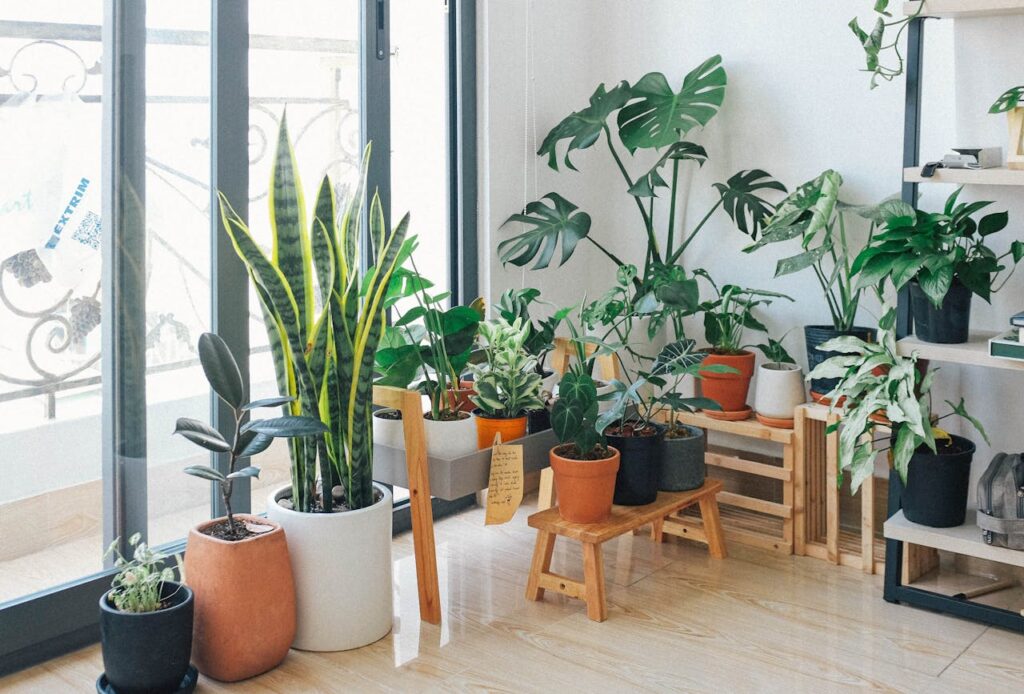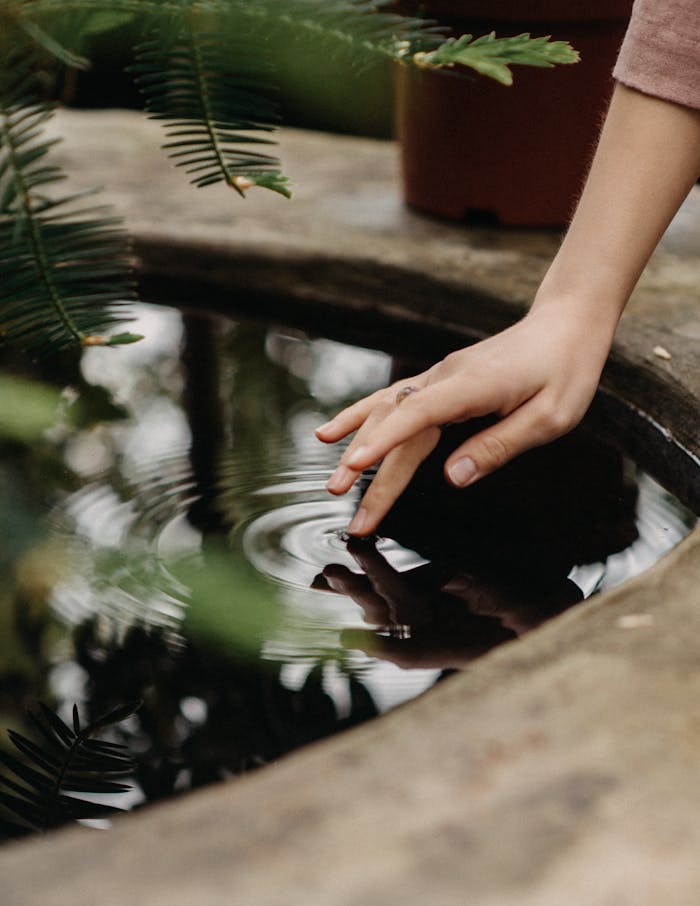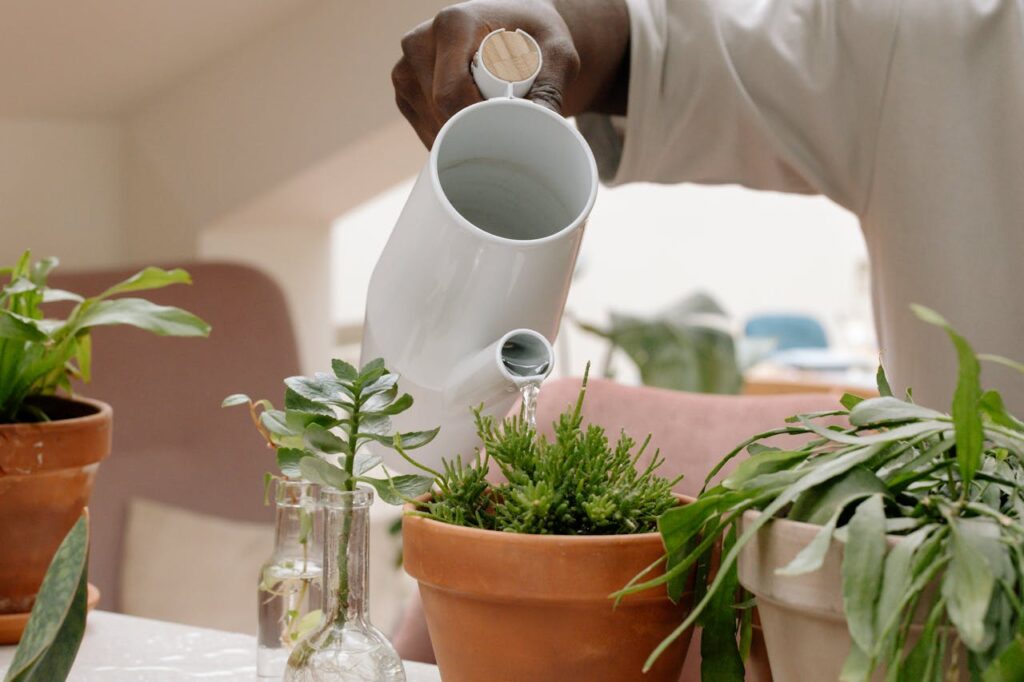Table of Contents
Are you looking to bring a touch of nature into your home but worried about your lack of gardening experience? Fear not! This guide to the best indoor plants for beginners will help you start your journey into the world of indoor gardening with confidence. We’ll explore the top 10 low-maintenance indoor plants that are perfect for novices, along with essential care tips to ensure your new green companions thrive.
Indoor plants not only enhance the aesthetic appeal of your living space but also offer numerous benefits for your health and well-being. They can purify the air, reduce stress, and even boost productivity. For beginners, choosing the right plants is crucial to building confidence and enjoying the rewards of plant parenthood. Let’s dive into our list of the top 10 beginner-friendly houseplants that will turn your home into a lush, green oasis.
Snake Plant (Sansevieria)
The Snake Plant, also known as Mother-in-Law’s Tongue, is one of the best indoor plants for beginners due to its incredibly hardy nature. This striking plant features tall, sword-like leaves with vibrant green and yellow variegation.
Care requirements:
- Light: Tolerates low to bright indirect light
- Water: Allow soil to dry completely between waterings
- Soil: Well-draining potting mix
Snake plants are excellent air-purifying plants for home environments, removing toxins like formaldehyde and benzene. They’re also one of the most drought-tolerant houseplants, making them perfect for forgetful waterers.
How to grow Snake Plant:
Place in a pot with drainage holes, use well-draining soil, and water sparingly. These plants prefer to be slightly rootbound, so don’t rush to repot them.
Pothos (Epipremnum aureum)
Pothos, also called Devil’s Ivy, is a versatile and easy-to-grow trailing plant that’s perfect for beginners. Its heart-shaped leaves come in various shades of green, and some varieties feature beautiful variegation.
Care requirements:
- Light: Adapts to low or bright indirect light
- Water: Allow top inch of soil to dry between waterings
- Soil: Standard potting mix
One of the best features of Pothos is its ease of propagation. Simply cut a stem with a leaf node and place it in water to grow roots.
How to plant Pothos:
Choose a hanging basket or place it on a shelf to showcase its trailing vines. Pothos is also an excellent choice for growing in water, making it a versatile decor element.
Spider Plant (Chlorophytum comosum)
Spider Plants are among the most popular beginner-friendly houseplants, known for their arching, grass-like leaves and small plantlets or “spiderettes” that dangle from long stems.
Care requirements:
- Light: Bright indirect light
- Water: Keep soil lightly moist
- Soil: Well-draining potting mix
Spider plants are excellent air-purifying plants, removing common household toxins. They’re also non-toxic to pets, making them a safe choice for animal lovers.
How to grow Spider Plant:
Place in a hanging basket to showcase its cascading form. Spider plants prefer to be slightly rootbound, so don’t overpot them.
ZZ Plant (Zamioculcas zamiifolia)
The ZZ Plant is a top choice for low-maintenance indoor plants. Its glossy, dark green leaves grow in a distinctive feather-like pattern, adding a touch of sophistication to any room.
Care requirements:
- Light: Tolerates low to bright indirect light
- Water: Allow soil to dry completely between waterings
- Soil: Well-draining potting mix
ZZ plants are incredibly drought-tolerant and can survive long periods without water, making them ideal for busy or forgetful plant parents.
How to plant ZZ Plant:
Choose a pot with good drainage and use a well-draining potting mix. These plants grow slowly, so they don’t need frequent repotting.
Peace Lily (Spathiphyllum)
Peace Lilies are elegant, low-maintenance indoor plants known for their glossy green leaves and white, hood-like flowers.
Care requirements:
- Light: Low to medium indirect light
- Water: Keep soil consistently moist
- Soil: Rich, well-draining potting mix
Peace Lilies are excellent air-purifying plants for home environments, effectively removing common indoor pollutants.
How to grow Peace Lily:
Place in a location with consistent indirect light and high humidity. These plants will let you know when they need water by drooping slightly.
Chinese Evergreen (Aglaonema)
Chinese Evergreens are perfect starter plants for indoor gardening, offering a variety of leaf patterns and colors.
Care requirements:
- Light: Low to medium indirect light
- Water: Allow top inch of soil to dry between waterings
- Soil: Well-draining potting mix
These plants are highly adaptable to low-light conditions, making them ideal for darker corners of your home.
How to plant Chinese Evergreen:
Use a well-draining potting mix in a container with drainage holes. These plants prefer to stay slightly rootbound, so don’t rush to repot.
Rubber Plant (Ficus elastica)
The Rubber Plant is a striking, easy-care houseplant with large, glossy leaves that can add a dramatic touch to any room.
Care requirements:
- Light: Bright indirect light
- Water: Allow top inch of soil to dry between waterings
- Soil: Well-draining potting mix
Rubber plants are excellent air-purifying plants and can grow quite tall, making them perfect statement pieces in your home.
How to grow Rubber Plant:
Place in a spot with consistent bright, indirect light. Rotate the plant regularly to ensure even growth.
Dracaena
Dracaena plants come in various species, all of which are excellent choices for beginners. They feature long, striped leaves and can range from compact tabletop plants to tall, tree-like specimens.
Care requirements:
- Light: Low to bright indirect light
- Water: Allow top inch of soil to dry between waterings
- Soil: Well-draining potting mix
Dracaenas are versatile in size and shape, making them suitable for various spaces in your home.
How to plant Dracaena:
Choose a pot with good drainage and use a well-draining potting mix. These plants are sensitive to fluoride, so consider using distilled or rainwater.
Philodendron
Philodendrons are classic, easy-to-grow houseplants that come in both climbing and non-climbing varieties. Their heart-shaped leaves and trailing vines make them popular choices for beginners.
Care requirements:
- Light: Medium to bright indirect light
- Water: Allow top inch of soil to dry between waterings
- Soil: Well-draining potting mix
Philodendrons are known for their air-purifying qualities and are incredibly easy to propagate.
How to grow Philodendron:
For climbing varieties, provide a moss pole or trellis for support. For trailing types, place in a hanging basket or on a high shelf.
Aloe Vera
Aloe Vera is a versatile succulent that’s not only easy to care for but also offers medicinal properties.
Care requirements:
- Light: Bright indirect light
- Water: Allow soil to dry completely between waterings
- Soil: Well-draining cactus or succulent mix
Aloe Vera is drought-tolerant and perfect for those who tend to forget watering their plants.
How to plant Aloe Vera:
Use a terracotta pot with drainage holes and a well-draining succulent mix. Place in a bright spot, but avoid direct sunlight which can scorch the leaves.
General Care Tips for Beginners
Understanding plant labels
When purchasing your plants, pay attention to the care labels. They provide valuable information about light requirements, watering needs, and mature size.
Proper potting techniques
Always use pots with drainage holes to prevent water from sitting in the soil and causing root rot. Choose a pot that’s slightly larger than the plant’s current container.
Watering best practices
Most indoor plants prefer to dry out slightly between waterings. Always check the soil moisture before watering, and when in doubt, it’s better to underwater than overwater.
Fertilizing basics
Use a balanced, water-soluble fertilizer during the growing season (spring and summer) to provide essential nutrients. Follow the package instructions for application rates.
Pest prevention and management
Regularly inspect your plants for signs of pests. If you notice any issues, isolate the affected plant and treat it with neem oil or insecticidal soap.
Conclusion
Starting your journey into indoor gardening doesn’t have to be daunting. With these top 10 indoor plants for beginners, you can create a thriving indoor garden with minimal effort. Remember, the key to success with easy-care houseplants is to observe your plants regularly and respond to their needs.
As you gain confidence in caring for these beginner-friendly houseplants, you’ll discover the joy and satisfaction of watching your green companions thrive. Indoor gardening is not just a hobby; it’s a rewarding experience that can improve your living space and overall well-being.


